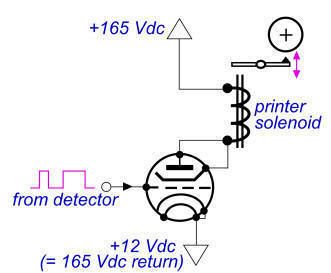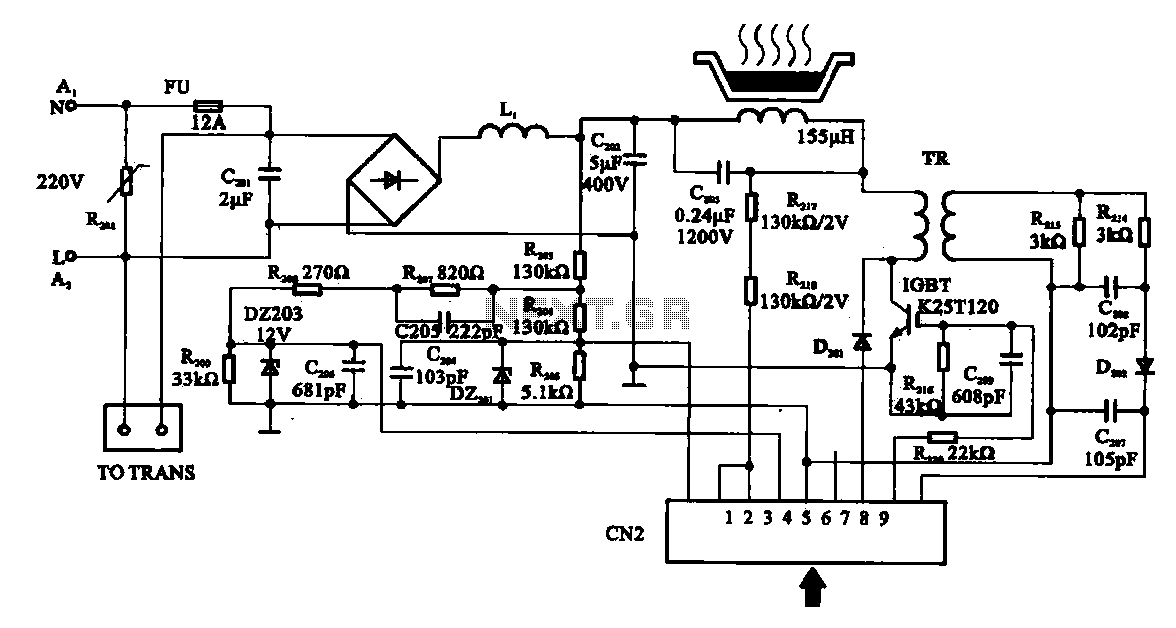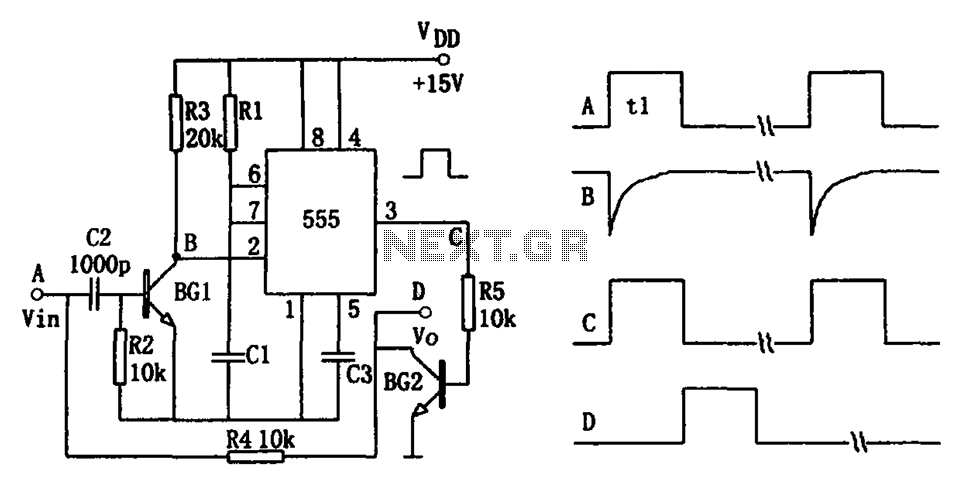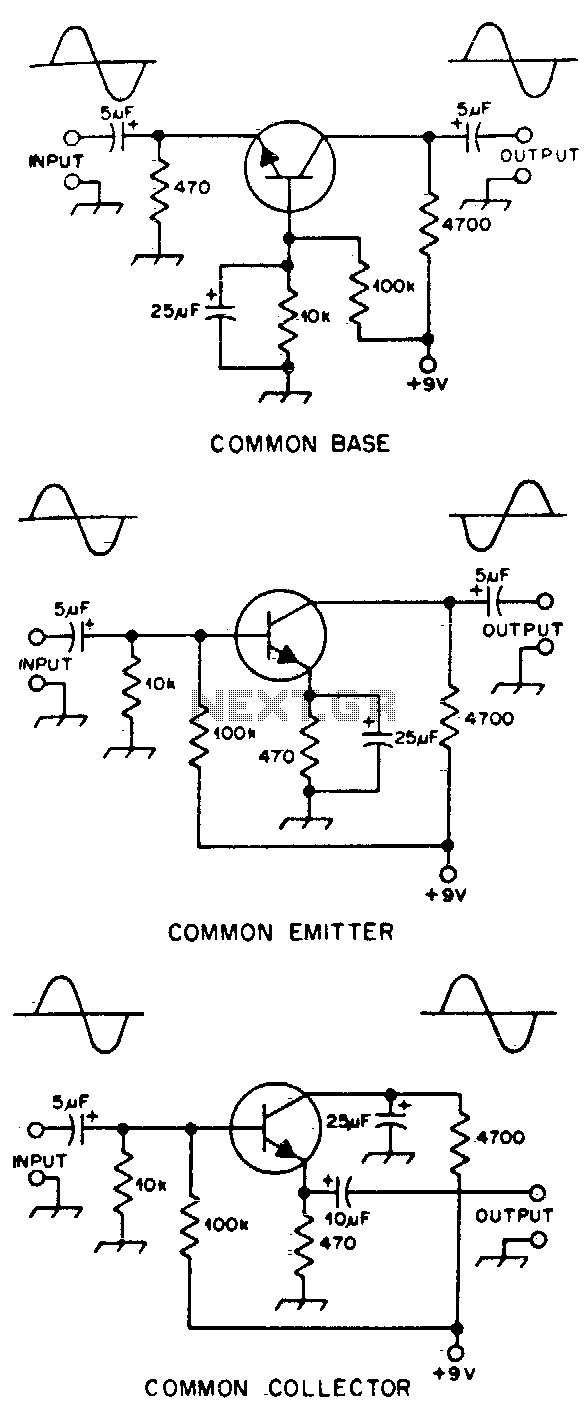
BASIC CIRCUITRY of Metal Detection

The search loop can be constructed in various ways; however, the method presented here should provide a solid foundation. Refer to Fig. 2 as a guide for assembling the loop. The loop should be made from non-metallic and moisture-resistant materials. A sealed wooden form, either solid or hoop-like, is suitable. The form should measure between ½ to 1 inch in width to accommodate the coil windings. Wind six close turns of #20 enameled or insulated wire around the form. Secure the windings with at least two layers of high-quality plastic electrical tape. Set the loop aside and build the oscillator circuit on a multipurpose PC board with pre-drilled holes. Stability is crucial when constructing any reliable oscillator circuit, so it is important to keep all component leads short and securely mounted. The two variable capacitors should be positioned to allow external tuning. For optimal performance, house the circuit in a metal cabinet connected to the circuit ground. Temporarily connect the loop to the circuitry using approximately 30 inches of shielded microphone cable or 2-conductor intercom wire, with wire gauges ranging from #18 to #24. Alternatively, two insulated wires can be twisted together by hand for use. Position the loop away from any metallic objects and apply power to the circuit. Place a transistor radio nearby and tune it to a station near the middle of the dial. Adjust both C5 and C6 to a frequency that will heterodyne with the broadcast station. If there is no response, the oscillator may not be operating at the desired frequency. To determine whether the oscillator's frequency is too low or too high, a frequency counter is the simplest solution. If unavailable, a shortwave receiver that operates both below and above the standard AM broadcast band can be used to find the oscillator's frequency. Once identified, adjustments can be made to align the frequency within the broadcast band. Reducing the total capacitance of the oscillator's tuned circuit or decreasing the inductance of the loop will increase the frequency. Conversely, increasing the capacitance of the tuned circuit or raising the inductance of the loop will lower the frequency. Modifying the number of turns in the loop is an effective method if the oscillator is significantly off frequency. The search loop typically scans the ground in a parallel orientation to detect metal objects. This parallel positioning creates capacitance to ground, which alters the oscillator's frequency. As the loop moves up and down above the ground, the oscillator's frequency changes accordingly. Incorporating a Faraday shield around the loop can mitigate ground-effect frequency shifts. The Faraday shield consists of a metal shroud surrounding the loop with an insulating gap in the center. This shield can be fashioned from aluminum foil by cutting a strip that is 3 inches wide and long enough to wrap almost completely around the loop while leaving a 1 to 2-inch gap. After shaping the aluminum foil, attach a 4-inch length of bare wire underneath the foil at one end and secure the shield in place. Position the loop on a flat surface and place a heavy object on top to ensure the foil adheres to the loop form. Once the adhesive has set, connect the other end of the bare wire to the loop's ground connection. A broom handle or dowel rod can be affixed to the center of the loop to serve as a handle and support for the loop and detector circuit. The AM radio can be attached to the handle or carried separately. Position the loop over the area to be searched and tune the oscillator to produce an audible beat frequency tone. Maximum sensitivity is achieved when the loop is correctly tuned and positioned.
The construction of a search loop for metal detection involves several critical design considerations. The choice of materials is paramount; non-metallic and moisture-resistant components help ensure the loop's durability and performance. The geometry of the loop, including its width and the number of turns of wire, directly influences its inductance and resonant frequency. The oscillator circuit must be designed for stability, with careful attention to lead lengths and component mounting to minimize parasitic capacitance and inductance.
When tuning the oscillator, it is essential to understand the relationship between capacitance, inductance, and frequency. The adjustments made to the variable capacitors (C5 and C6) allow for fine-tuning the oscillator to match the frequency of nearby radio stations, thus enabling effective detection of metal objects through heterodyning. The use of a frequency counter or shortwave receiver provides a means to accurately assess the oscillator's output frequency, facilitating precise tuning.
The incorporation of a Faraday shield serves to reduce the impact of ground capacitance on the oscillator's frequency, thereby improving detection reliability. By creating a controlled environment around the loop, the shield minimizes unwanted frequency shifts that can occur due to variations in ground conditions.
The ergonomic design of the search loop, including a handle for ease of use, enhances the user experience during operation. The overall assembly must be robust yet lightweight to allow for extended use without fatigue. This careful consideration of both electronic and mechanical aspects culminates in a functional and effective metal detection system.The search loop may be constructed in several different ways; however, the method offered here should get you headed in the right direction. Refer to Fig. 2 as a guide for constructing the loop. The loop form should be constructed from non-metallic and non-moisture-absorbent material. A sealed wood form will do, and it can be either solid or hoop- like. The form should be % to 1 inch wide to allow room for the coil windings. Close wind six turns of #20 enameled or insulated wire on the form. Wrap the windings with at least two layers of good quality plastic electrical tape. Put the loop aside and construct the oscillator circuit on a piece of multipurpose PC board with pre-drilled holes. Stability is one of the most important considerations in building any stable oscillator circuit, so keep all component leads short and solidly mounted.
The two variable capacitors should be mounted in a manner that allows tuning from outside the enclosure. In order to achieve the best results, the circuit should be housed in a metal cabinet to which the circuit ground is connected.
Temporarily connect the loop to the circuitry with about 30 inches of shielded microphone cable or 2-conductor intercom wire. Any wire gauge from #18 to #24 will do. Actually two insulated wires may be twisted together by hand and used. Place the loop away from any metal object and apply power to the circuit. Locate a transistor radio near by and tune in a station somewhere near the middle of the dial. Adjust both C5 and C6 to a frequency that will heterodyne with the broadcast station. If nothing happens, it is most likely that the oscillator is not operating near the desired frequency.
Now, how do we determine if the oscillator`s frequency is too low or too high Naturally, a frequency counter would be the easiest way to determine the oscillator`s frequency. If one is not available, what then A shortwave receiver that runes both below and above the standard AM broadcast band can be used to ferret out the oscillator`s frequency.
Once the oscillator`s frequency is determined, adjustments can be made to move the frequency into the broadcast band. Reducing the total capacitance of the oscillator`s tuned circuit or lowering the inductance of the loop will raise the frequency.
Lowering the frequency is accomplished by increasing the capacitance of the tuned circuit or by increasing the inductance of the loop. Removing or adding a turn to the loop is a good method to use if the oscillator is way off frequency.
The search loop normally scans the ground in a parallel manner in search of metal objects. The loop`s parallel position to the ground forms a capacitance to ground, which shifts the oscillator`s frequency. As the loop moves up and down above the ground, the oscillator`s frequency shifts in a like manner. Adding a Faraday shield to the loop will help in reducing the ground-effect frequency-shift problem. The Faraday shield is a metal shroud that is formed around the loop with an insulating gap in the middle.
A shield can be formed out of aluminum foil by cutting a length that`s 3 inches wide and long enough to go almost completely around the edge of the loop while leaving a gap of 1 to 2 inches in the middle, see Fig. 3. Once the aluminum foil is formed, add a 4-inch length bare wire under the foil at one end and glue the shield in place.
Place the loop on a flat surface and place a solid object on top to secure the foil to the loop form. After the glue dries, connect the other end of the bare wire to the loop`s ground-end connection. An old broom handle or dowel rod is attached to the middle of the loop and serves as the handle and support for the loop and detector circuit.
See Fig. 4. The AM radio may be attached to the handle as well or carried separately. Position the loop over the area to be searched and tune the oscillator to produce an audible beat frequency tone. Maximum sensitivity is achieved wh 🔗 External reference
The construction of a search loop for metal detection involves several critical design considerations. The choice of materials is paramount; non-metallic and moisture-resistant components help ensure the loop's durability and performance. The geometry of the loop, including its width and the number of turns of wire, directly influences its inductance and resonant frequency. The oscillator circuit must be designed for stability, with careful attention to lead lengths and component mounting to minimize parasitic capacitance and inductance.
When tuning the oscillator, it is essential to understand the relationship between capacitance, inductance, and frequency. The adjustments made to the variable capacitors (C5 and C6) allow for fine-tuning the oscillator to match the frequency of nearby radio stations, thus enabling effective detection of metal objects through heterodyning. The use of a frequency counter or shortwave receiver provides a means to accurately assess the oscillator's output frequency, facilitating precise tuning.
The incorporation of a Faraday shield serves to reduce the impact of ground capacitance on the oscillator's frequency, thereby improving detection reliability. By creating a controlled environment around the loop, the shield minimizes unwanted frequency shifts that can occur due to variations in ground conditions.
The ergonomic design of the search loop, including a handle for ease of use, enhances the user experience during operation. The overall assembly must be robust yet lightweight to allow for extended use without fatigue. This careful consideration of both electronic and mechanical aspects culminates in a functional and effective metal detection system.The search loop may be constructed in several different ways; however, the method offered here should get you headed in the right direction. Refer to Fig. 2 as a guide for constructing the loop. The loop form should be constructed from non-metallic and non-moisture-absorbent material. A sealed wood form will do, and it can be either solid or hoop- like. The form should be % to 1 inch wide to allow room for the coil windings. Close wind six turns of #20 enameled or insulated wire on the form. Wrap the windings with at least two layers of good quality plastic electrical tape. Put the loop aside and construct the oscillator circuit on a piece of multipurpose PC board with pre-drilled holes. Stability is one of the most important considerations in building any stable oscillator circuit, so keep all component leads short and solidly mounted.
The two variable capacitors should be mounted in a manner that allows tuning from outside the enclosure. In order to achieve the best results, the circuit should be housed in a metal cabinet to which the circuit ground is connected.
Temporarily connect the loop to the circuitry with about 30 inches of shielded microphone cable or 2-conductor intercom wire. Any wire gauge from #18 to #24 will do. Actually two insulated wires may be twisted together by hand and used. Place the loop away from any metal object and apply power to the circuit. Locate a transistor radio near by and tune in a station somewhere near the middle of the dial. Adjust both C5 and C6 to a frequency that will heterodyne with the broadcast station. If nothing happens, it is most likely that the oscillator is not operating near the desired frequency.
Now, how do we determine if the oscillator`s frequency is too low or too high Naturally, a frequency counter would be the easiest way to determine the oscillator`s frequency. If one is not available, what then A shortwave receiver that runes both below and above the standard AM broadcast band can be used to ferret out the oscillator`s frequency.
Once the oscillator`s frequency is determined, adjustments can be made to move the frequency into the broadcast band. Reducing the total capacitance of the oscillator`s tuned circuit or lowering the inductance of the loop will raise the frequency.
Lowering the frequency is accomplished by increasing the capacitance of the tuned circuit or by increasing the inductance of the loop. Removing or adding a turn to the loop is a good method to use if the oscillator is way off frequency.
The search loop normally scans the ground in a parallel manner in search of metal objects. The loop`s parallel position to the ground forms a capacitance to ground, which shifts the oscillator`s frequency. As the loop moves up and down above the ground, the oscillator`s frequency shifts in a like manner. Adding a Faraday shield to the loop will help in reducing the ground-effect frequency-shift problem. The Faraday shield is a metal shroud that is formed around the loop with an insulating gap in the middle.
A shield can be formed out of aluminum foil by cutting a length that`s 3 inches wide and long enough to go almost completely around the edge of the loop while leaving a gap of 1 to 2 inches in the middle, see Fig. 3. Once the aluminum foil is formed, add a 4-inch length bare wire under the foil at one end and glue the shield in place.
Place the loop on a flat surface and place a solid object on top to secure the foil to the loop form. After the glue dries, connect the other end of the bare wire to the loop`s ground-end connection. An old broom handle or dowel rod is attached to the middle of the loop and serves as the handle and support for the loop and detector circuit.
See Fig. 4. The AM radio may be attached to the handle as well or carried separately. Position the loop over the area to be searched and tune the oscillator to produce an audible beat frequency tone. Maximum sensitivity is achieved wh 🔗 External reference





